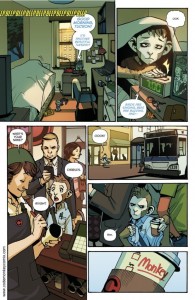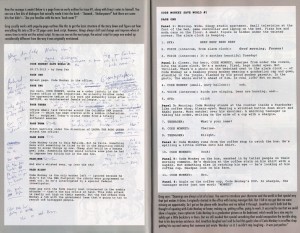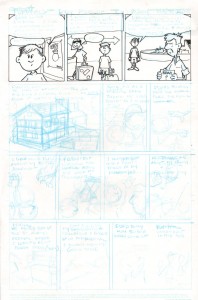Last week I gave you a simple project for your class… take a scene from a book and make it into a comic. this should have been maybe a page or two, but nothing too complex, just rewriting a scene. How do you branch beyond that- here is another idea. Next week you’ll get an even more open ended one, but again we are focusing on the basics, building a foundation.
The Comic “Book Review”. This is another simple one page project, but it gets the students to start writing their own scripts. A script is important as they branch into longer stories. I have hunted down some trade paper backs that include the original script. My current favorite for this is Code Monkey Save World. While not completely all ages – the song isn’t for younger kids due to some language (PG- but will get giggles and irate parents in a younger classroom). I use the script by Greg Pak and a copy of the first page to show how the process works. It’s pretty simple since the lyrics used for page one are just “Code Monkey get up, get coffee, Code Monkey go to job.”
It becomes much more as a comic…

and a script including the notes about changes (proving that writers do go through drafts).

So for Mentor Texts I bring up The Comic Critic and Unshelved’s Book Club both are web comics that are simple one page reviews of books and movies. As with any internet resource some may not be appropriate for all classes, you know your community. We can analyze how they provide limited information and persuade us one way or another.
As the students work on this they start to work a little more on drafts, scripts, page layout and character design. Some will find that the author has given them no details about the main character, and setting while others have overwhelmed us with exacting details. As a teacher this is where you guide them into searching out details and making a list. If the author mentions a characters favorite color… write it down. If they like baseball, make sure they wear a baseball cap, those kinds of things. If the author doesn’t, then the student needs to fill in the details, and create the character. Fortunately, in most cases students are reading realistic fiction so it’s pretty easy for them to draw someone.
The review is also a great chance for you, the teacher, to model what you want. Pick a book that you have read aloud in class and use that as an example. When I did this with my class I chose Funerals and Fly Fishing by Mary Bartek. As a class we talked about the major plot points and what I shouldn’t tell people in my review/summary *spoilers*. As I plotted and laid out the page I used it as an example of how to finish a panel. I had enough panels that I could do it over and over again with multiple students. Like the first example last week, it will take longer than you think.

You can see in my example one- that it isn’t finished and two- that I used blue pencil. to draw with. Why? I’m pretty old school I draw my comics using non-photo blue pencil and then ink over that. When I scan my work anything blue magically vanishes, all that’s left is the black line. I use a Prismacolor Verithin pencil, but there are others out there. When I did this project each student got a non-photo blue pencil and a piece of comic book paper (I chose the cheapest paper from Blueline Pro) but the kids thought they were cool drawing on real comic book pages. When they were done, I scanned each page and then printed it out. Each student had their original art and a black and white finished product that they could hand color if they wanted to.
So far we’ve focused mostly on using comics in Language Arts. Next week I’m going to share a larger comic project that involves integrating Science.

